Consumer Behavior and Influences: Woolworths Report
VerifiedAdded on 2022/09/09
|17
|4313
|12
Report
AI Summary
This report analyzes consumer buying behavior, focusing on cultural and interpersonal influences, using Woolworths as a case study. It explores how factors like age, gender, morality, cultural values, identity, social media, personality, peer pressure, and food habits shape customer behavior. The report examines ethical business practices, gender dynamics, parental influence, and the impact of peers on consumer choices within the Australian context. It also considers the influence of online shopping and ethical standards. Recommendations are provided for Woolworths to enhance and maintain its competitive advantage by understanding and adapting to these various influences. The study highlights the importance of product diversification, price range, and understanding cultural differences to attract a diverse consumer base.
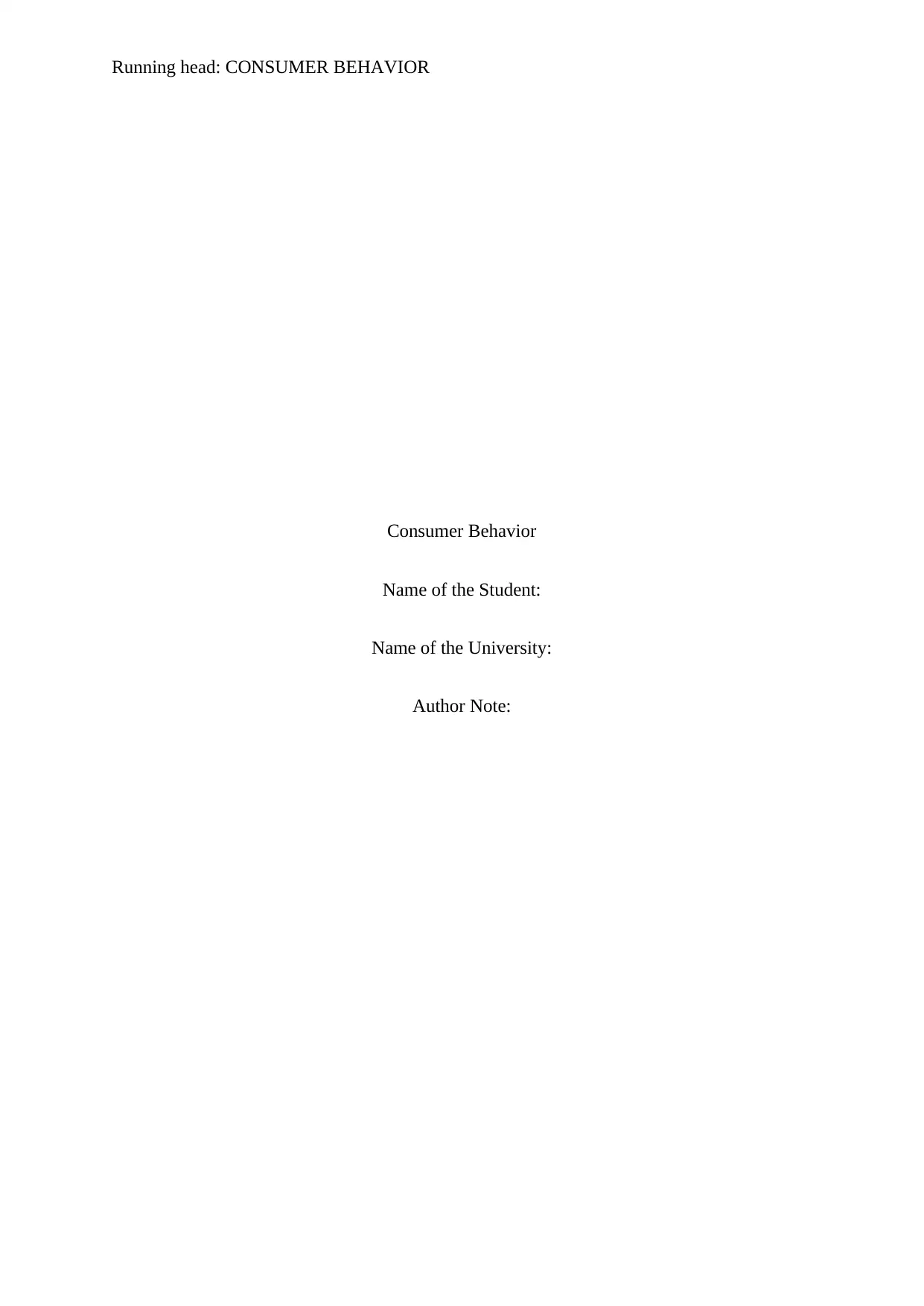
Running head: CONSUMER BEHAVIOR
Consumer Behavior
Name of the Student:
Name of the University:
Author Note:
Consumer Behavior
Name of the Student:
Name of the University:
Author Note:
Paraphrase This Document
Need a fresh take? Get an instant paraphrase of this document with our AI Paraphraser
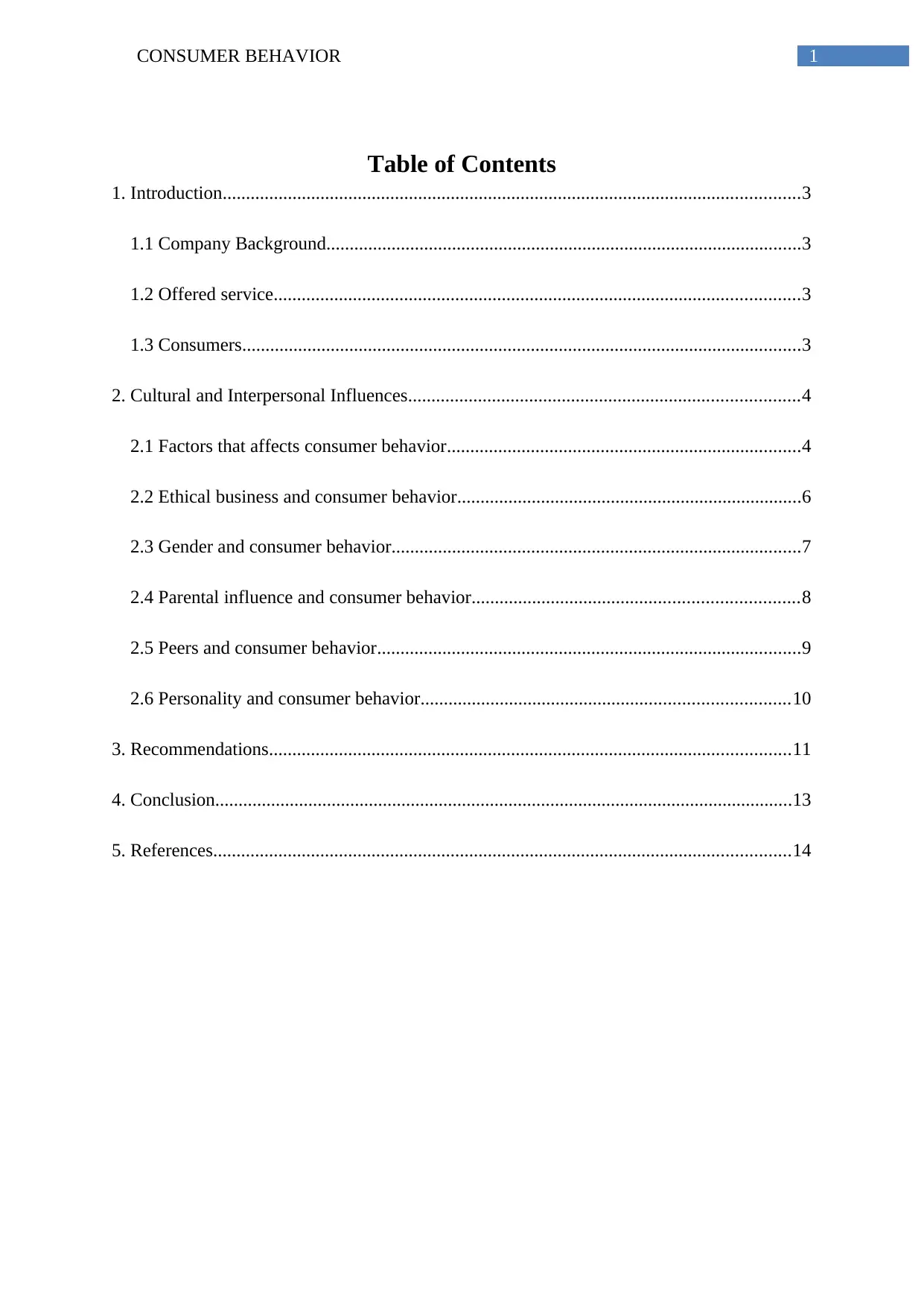
1CONSUMER BEHAVIOR
Table of Contents
1. Introduction............................................................................................................................3
1.1 Company Background......................................................................................................3
1.2 Offered service.................................................................................................................3
1.3 Consumers........................................................................................................................3
2. Cultural and Interpersonal Influences....................................................................................4
2.1 Factors that affects consumer behavior............................................................................4
2.2 Ethical business and consumer behavior..........................................................................6
2.3 Gender and consumer behavior........................................................................................7
2.4 Parental influence and consumer behavior......................................................................8
2.5 Peers and consumer behavior...........................................................................................9
2.6 Personality and consumer behavior...............................................................................10
3. Recommendations................................................................................................................11
4. Conclusion............................................................................................................................13
5. References............................................................................................................................14
Table of Contents
1. Introduction............................................................................................................................3
1.1 Company Background......................................................................................................3
1.2 Offered service.................................................................................................................3
1.3 Consumers........................................................................................................................3
2. Cultural and Interpersonal Influences....................................................................................4
2.1 Factors that affects consumer behavior............................................................................4
2.2 Ethical business and consumer behavior..........................................................................6
2.3 Gender and consumer behavior........................................................................................7
2.4 Parental influence and consumer behavior......................................................................8
2.5 Peers and consumer behavior...........................................................................................9
2.6 Personality and consumer behavior...............................................................................10
3. Recommendations................................................................................................................11
4. Conclusion............................................................................................................................13
5. References............................................................................................................................14
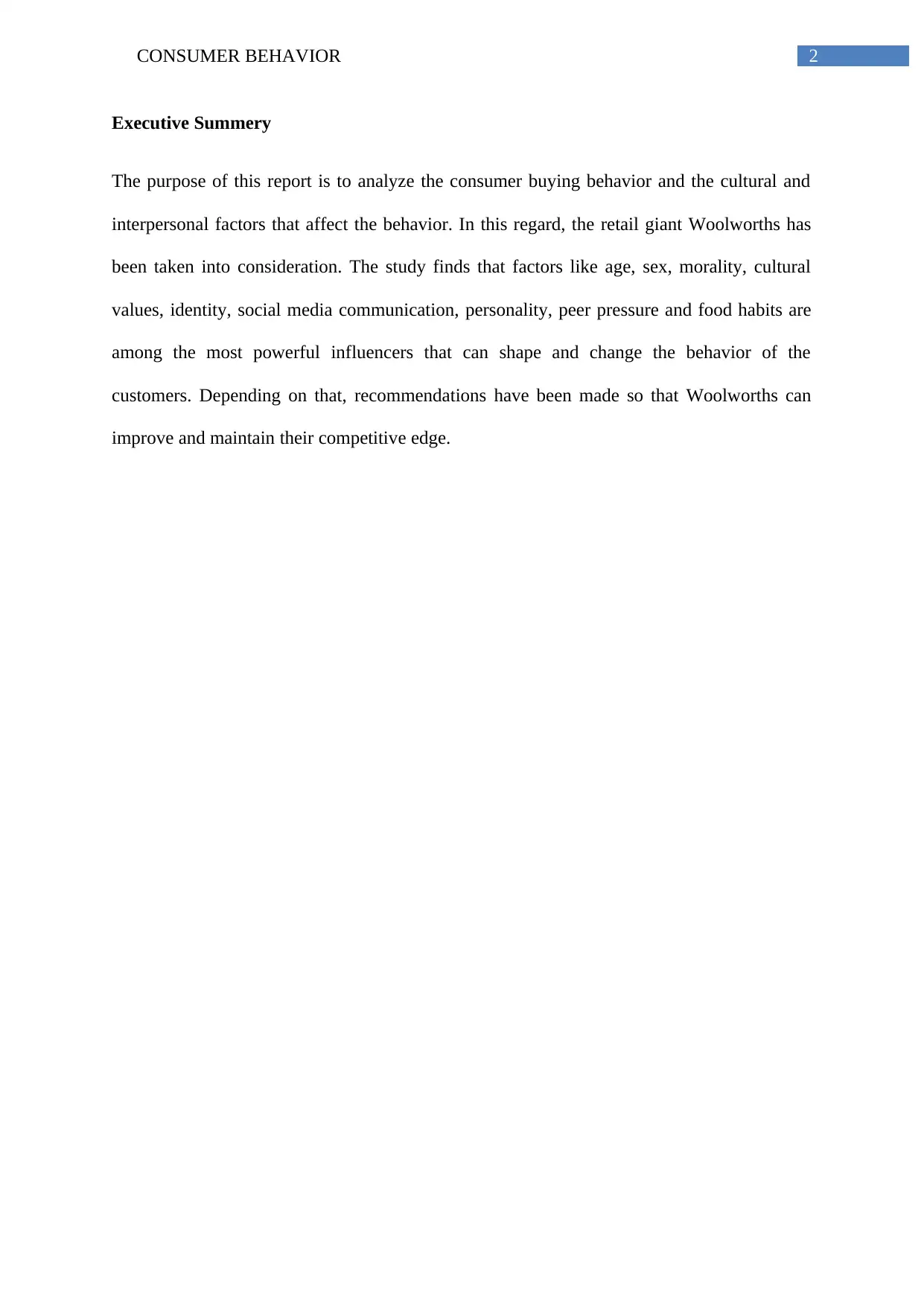
2CONSUMER BEHAVIOR
Executive Summery
The purpose of this report is to analyze the consumer buying behavior and the cultural and
interpersonal factors that affect the behavior. In this regard, the retail giant Woolworths has
been taken into consideration. The study finds that factors like age, sex, morality, cultural
values, identity, social media communication, personality, peer pressure and food habits are
among the most powerful influencers that can shape and change the behavior of the
customers. Depending on that, recommendations have been made so that Woolworths can
improve and maintain their competitive edge.
Executive Summery
The purpose of this report is to analyze the consumer buying behavior and the cultural and
interpersonal factors that affect the behavior. In this regard, the retail giant Woolworths has
been taken into consideration. The study finds that factors like age, sex, morality, cultural
values, identity, social media communication, personality, peer pressure and food habits are
among the most powerful influencers that can shape and change the behavior of the
customers. Depending on that, recommendations have been made so that Woolworths can
improve and maintain their competitive edge.
⊘ This is a preview!⊘
Do you want full access?
Subscribe today to unlock all pages.

Trusted by 1+ million students worldwide
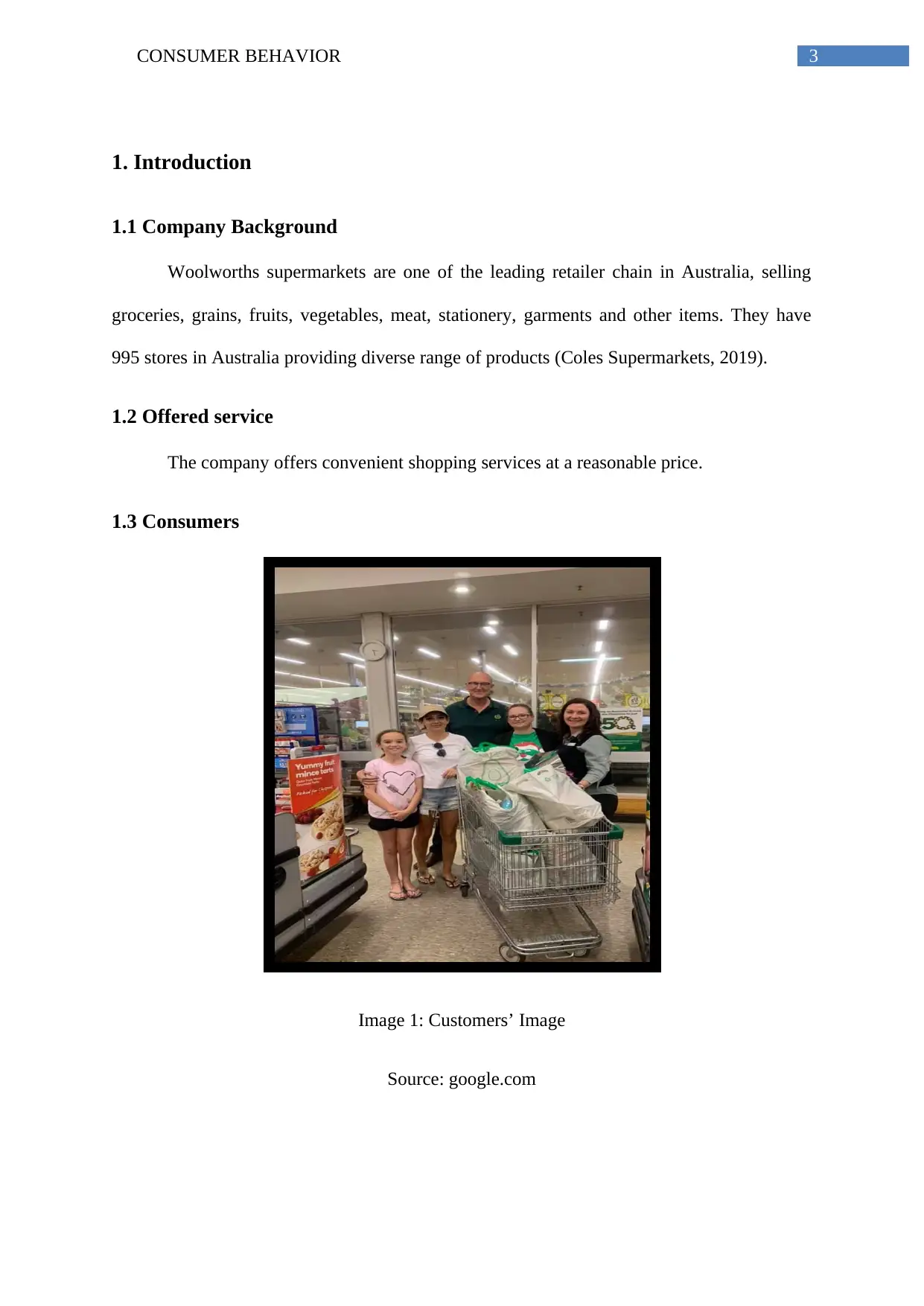
3CONSUMER BEHAVIOR
1. Introduction
1.1 Company Background
Woolworths supermarkets are one of the leading retailer chain in Australia, selling
groceries, grains, fruits, vegetables, meat, stationery, garments and other items. They have
995 stores in Australia providing diverse range of products (Coles Supermarkets, 2019).
1.2 Offered service
The company offers convenient shopping services at a reasonable price.
1.3 Consumers
Image 1: Customers’ Image
Source: google.com
1. Introduction
1.1 Company Background
Woolworths supermarkets are one of the leading retailer chain in Australia, selling
groceries, grains, fruits, vegetables, meat, stationery, garments and other items. They have
995 stores in Australia providing diverse range of products (Coles Supermarkets, 2019).
1.2 Offered service
The company offers convenient shopping services at a reasonable price.
1.3 Consumers
Image 1: Customers’ Image
Source: google.com
Paraphrase This Document
Need a fresh take? Get an instant paraphrase of this document with our AI Paraphraser
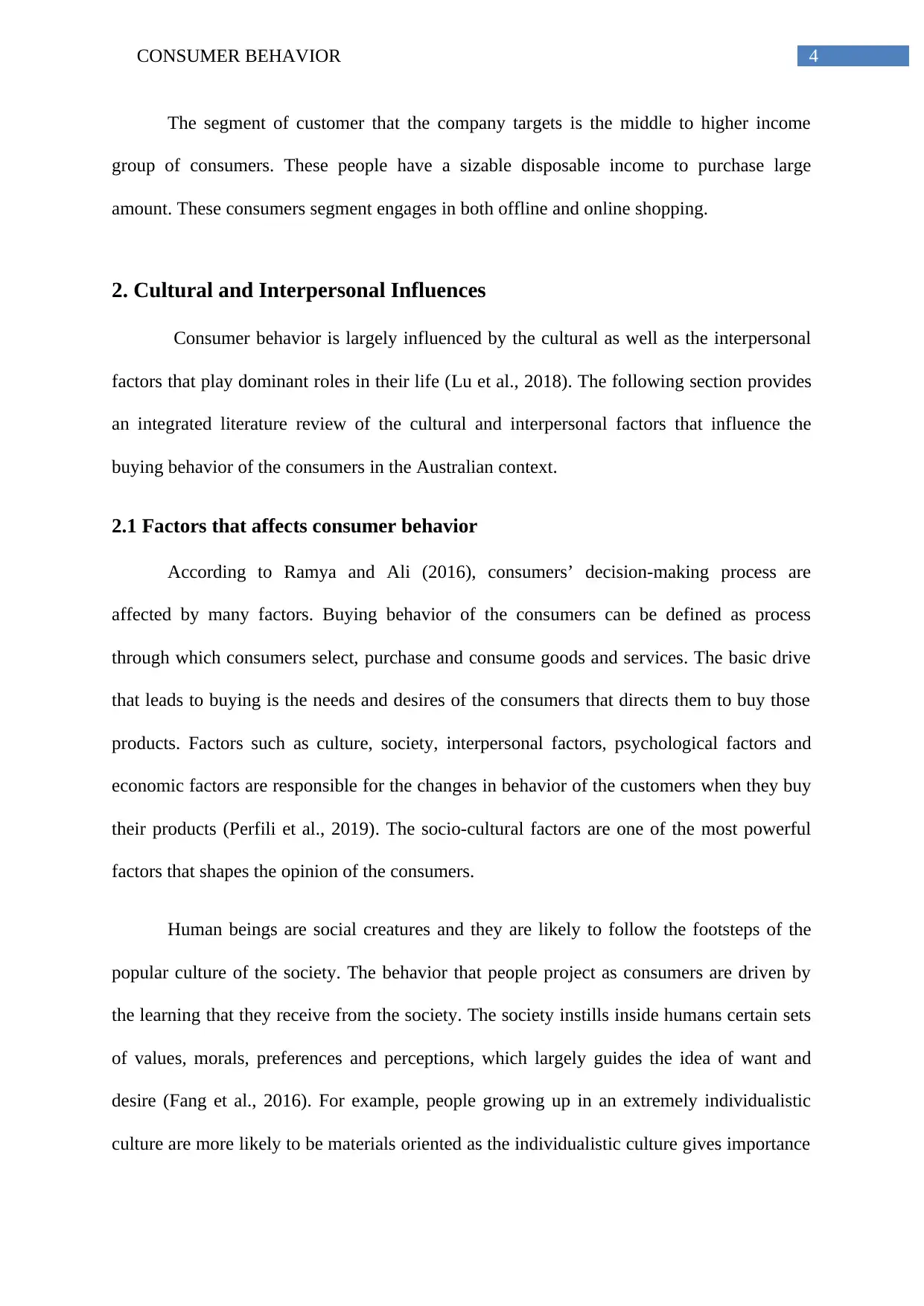
4CONSUMER BEHAVIOR
The segment of customer that the company targets is the middle to higher income
group of consumers. These people have a sizable disposable income to purchase large
amount. These consumers segment engages in both offline and online shopping.
2. Cultural and Interpersonal Influences
Consumer behavior is largely influenced by the cultural as well as the interpersonal
factors that play dominant roles in their life (Lu et al., 2018). The following section provides
an integrated literature review of the cultural and interpersonal factors that influence the
buying behavior of the consumers in the Australian context.
2.1 Factors that affects consumer behavior
According to Ramya and Ali (2016), consumers’ decision-making process are
affected by many factors. Buying behavior of the consumers can be defined as process
through which consumers select, purchase and consume goods and services. The basic drive
that leads to buying is the needs and desires of the consumers that directs them to buy those
products. Factors such as culture, society, interpersonal factors, psychological factors and
economic factors are responsible for the changes in behavior of the customers when they buy
their products (Perfili et al., 2019). The socio-cultural factors are one of the most powerful
factors that shapes the opinion of the consumers.
Human beings are social creatures and they are likely to follow the footsteps of the
popular culture of the society. The behavior that people project as consumers are driven by
the learning that they receive from the society. The society instills inside humans certain sets
of values, morals, preferences and perceptions, which largely guides the idea of want and
desire (Fang et al., 2016). For example, people growing up in an extremely individualistic
culture are more likely to be materials oriented as the individualistic culture gives importance
The segment of customer that the company targets is the middle to higher income
group of consumers. These people have a sizable disposable income to purchase large
amount. These consumers segment engages in both offline and online shopping.
2. Cultural and Interpersonal Influences
Consumer behavior is largely influenced by the cultural as well as the interpersonal
factors that play dominant roles in their life (Lu et al., 2018). The following section provides
an integrated literature review of the cultural and interpersonal factors that influence the
buying behavior of the consumers in the Australian context.
2.1 Factors that affects consumer behavior
According to Ramya and Ali (2016), consumers’ decision-making process are
affected by many factors. Buying behavior of the consumers can be defined as process
through which consumers select, purchase and consume goods and services. The basic drive
that leads to buying is the needs and desires of the consumers that directs them to buy those
products. Factors such as culture, society, interpersonal factors, psychological factors and
economic factors are responsible for the changes in behavior of the customers when they buy
their products (Perfili et al., 2019). The socio-cultural factors are one of the most powerful
factors that shapes the opinion of the consumers.
Human beings are social creatures and they are likely to follow the footsteps of the
popular culture of the society. The behavior that people project as consumers are driven by
the learning that they receive from the society. The society instills inside humans certain sets
of values, morals, preferences and perceptions, which largely guides the idea of want and
desire (Fang et al., 2016). For example, people growing up in an extremely individualistic
culture are more likely to be materials oriented as the individualistic culture gives importance
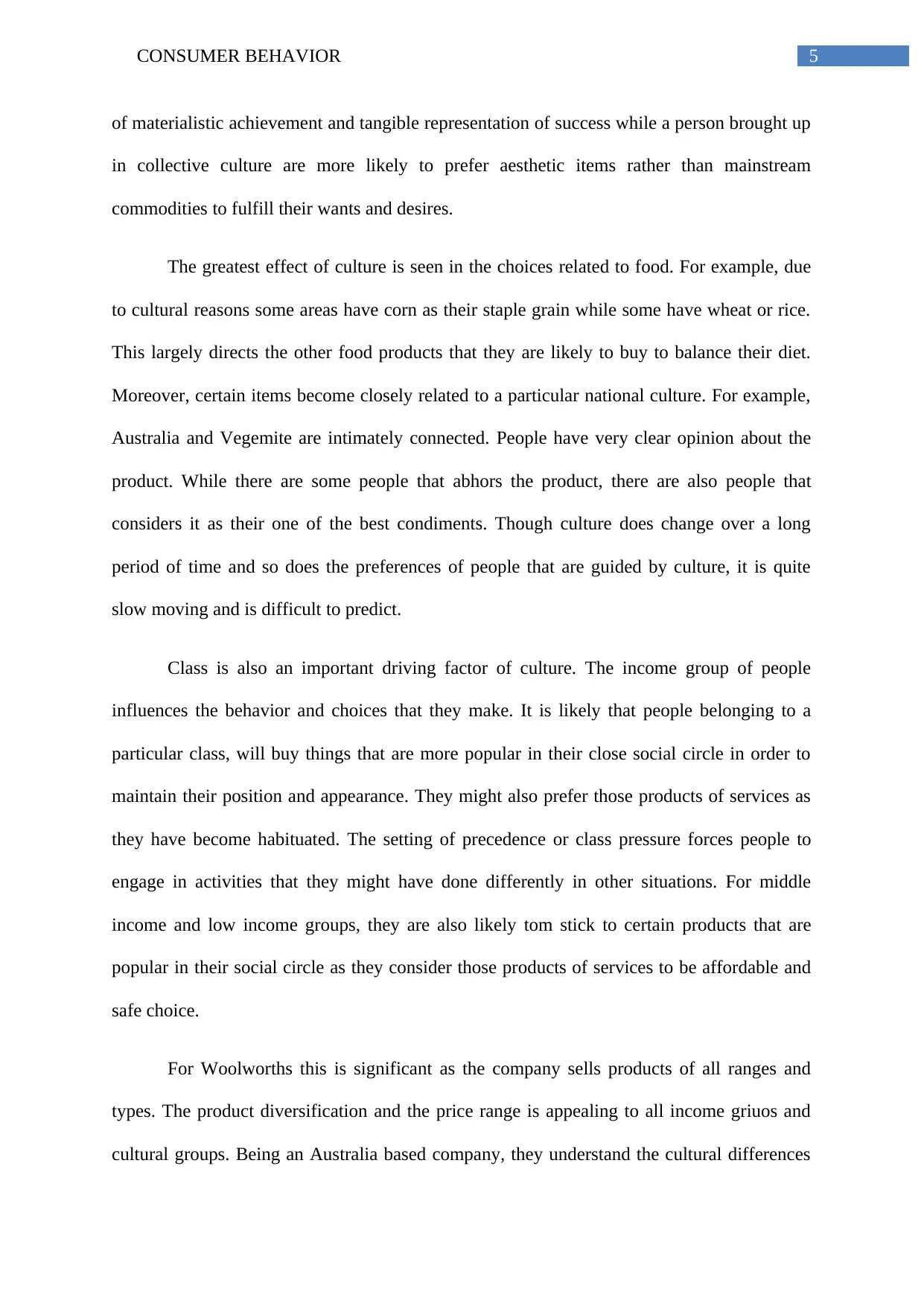
5CONSUMER BEHAVIOR
of materialistic achievement and tangible representation of success while a person brought up
in collective culture are more likely to prefer aesthetic items rather than mainstream
commodities to fulfill their wants and desires.
The greatest effect of culture is seen in the choices related to food. For example, due
to cultural reasons some areas have corn as their staple grain while some have wheat or rice.
This largely directs the other food products that they are likely to buy to balance their diet.
Moreover, certain items become closely related to a particular national culture. For example,
Australia and Vegemite are intimately connected. People have very clear opinion about the
product. While there are some people that abhors the product, there are also people that
considers it as their one of the best condiments. Though culture does change over a long
period of time and so does the preferences of people that are guided by culture, it is quite
slow moving and is difficult to predict.
Class is also an important driving factor of culture. The income group of people
influences the behavior and choices that they make. It is likely that people belonging to a
particular class, will buy things that are more popular in their close social circle in order to
maintain their position and appearance. They might also prefer those products of services as
they have become habituated. The setting of precedence or class pressure forces people to
engage in activities that they might have done differently in other situations. For middle
income and low income groups, they are also likely tom stick to certain products that are
popular in their social circle as they consider those products of services to be affordable and
safe choice.
For Woolworths this is significant as the company sells products of all ranges and
types. The product diversification and the price range is appealing to all income griuos and
cultural groups. Being an Australia based company, they understand the cultural differences
of materialistic achievement and tangible representation of success while a person brought up
in collective culture are more likely to prefer aesthetic items rather than mainstream
commodities to fulfill their wants and desires.
The greatest effect of culture is seen in the choices related to food. For example, due
to cultural reasons some areas have corn as their staple grain while some have wheat or rice.
This largely directs the other food products that they are likely to buy to balance their diet.
Moreover, certain items become closely related to a particular national culture. For example,
Australia and Vegemite are intimately connected. People have very clear opinion about the
product. While there are some people that abhors the product, there are also people that
considers it as their one of the best condiments. Though culture does change over a long
period of time and so does the preferences of people that are guided by culture, it is quite
slow moving and is difficult to predict.
Class is also an important driving factor of culture. The income group of people
influences the behavior and choices that they make. It is likely that people belonging to a
particular class, will buy things that are more popular in their close social circle in order to
maintain their position and appearance. They might also prefer those products of services as
they have become habituated. The setting of precedence or class pressure forces people to
engage in activities that they might have done differently in other situations. For middle
income and low income groups, they are also likely tom stick to certain products that are
popular in their social circle as they consider those products of services to be affordable and
safe choice.
For Woolworths this is significant as the company sells products of all ranges and
types. The product diversification and the price range is appealing to all income griuos and
cultural groups. Being an Australia based company, they understand the cultural differences
⊘ This is a preview!⊘
Do you want full access?
Subscribe today to unlock all pages.

Trusted by 1+ million students worldwide
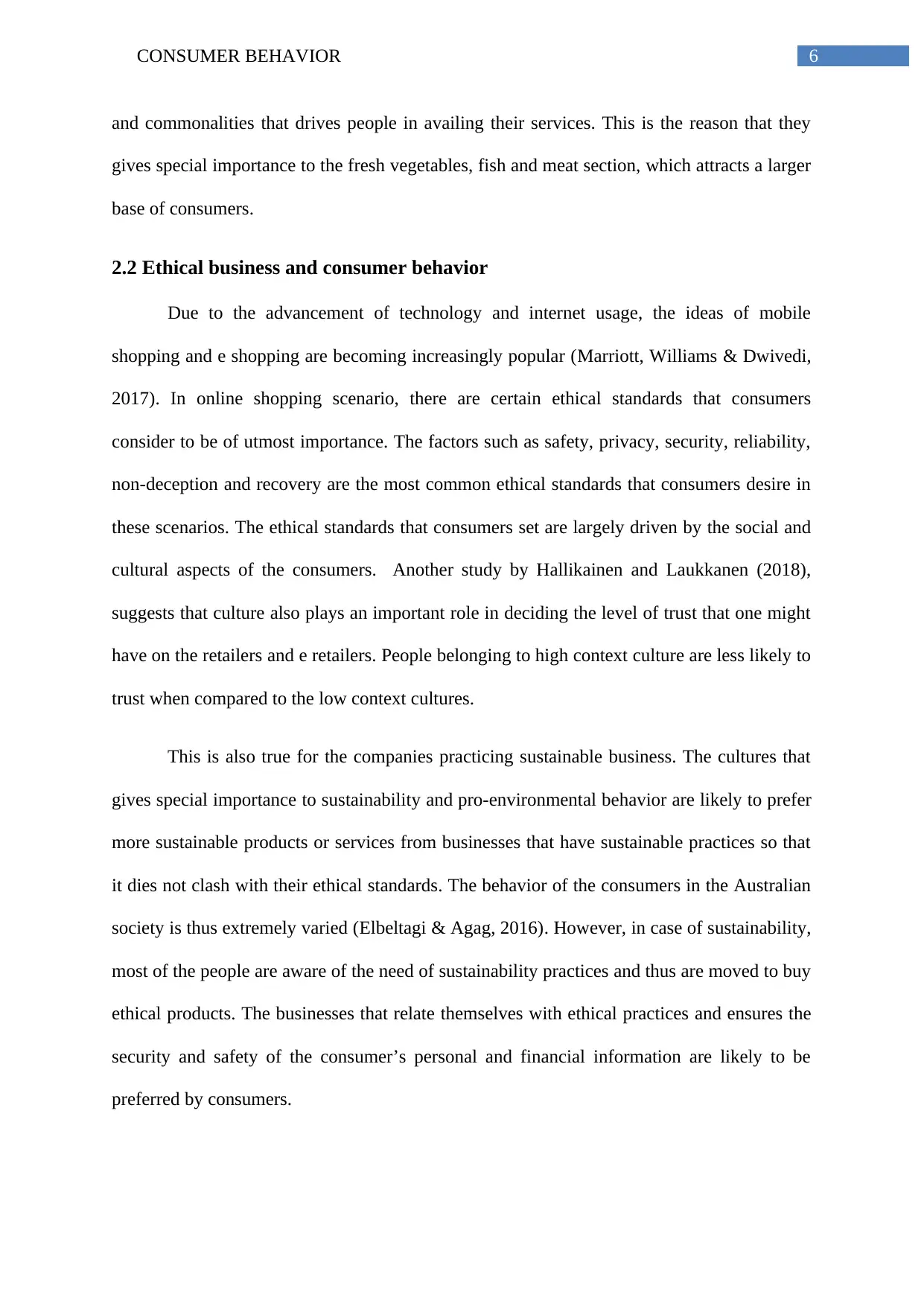
6CONSUMER BEHAVIOR
and commonalities that drives people in availing their services. This is the reason that they
gives special importance to the fresh vegetables, fish and meat section, which attracts a larger
base of consumers.
2.2 Ethical business and consumer behavior
Due to the advancement of technology and internet usage, the ideas of mobile
shopping and e shopping are becoming increasingly popular (Marriott, Williams & Dwivedi,
2017). In online shopping scenario, there are certain ethical standards that consumers
consider to be of utmost importance. The factors such as safety, privacy, security, reliability,
non-deception and recovery are the most common ethical standards that consumers desire in
these scenarios. The ethical standards that consumers set are largely driven by the social and
cultural aspects of the consumers. Another study by Hallikainen and Laukkanen (2018),
suggests that culture also plays an important role in deciding the level of trust that one might
have on the retailers and e retailers. People belonging to high context culture are less likely to
trust when compared to the low context cultures.
This is also true for the companies practicing sustainable business. The cultures that
gives special importance to sustainability and pro-environmental behavior are likely to prefer
more sustainable products or services from businesses that have sustainable practices so that
it dies not clash with their ethical standards. The behavior of the consumers in the Australian
society is thus extremely varied (Elbeltagi & Agag, 2016). However, in case of sustainability,
most of the people are aware of the need of sustainability practices and thus are moved to buy
ethical products. The businesses that relate themselves with ethical practices and ensures the
security and safety of the consumer’s personal and financial information are likely to be
preferred by consumers.
and commonalities that drives people in availing their services. This is the reason that they
gives special importance to the fresh vegetables, fish and meat section, which attracts a larger
base of consumers.
2.2 Ethical business and consumer behavior
Due to the advancement of technology and internet usage, the ideas of mobile
shopping and e shopping are becoming increasingly popular (Marriott, Williams & Dwivedi,
2017). In online shopping scenario, there are certain ethical standards that consumers
consider to be of utmost importance. The factors such as safety, privacy, security, reliability,
non-deception and recovery are the most common ethical standards that consumers desire in
these scenarios. The ethical standards that consumers set are largely driven by the social and
cultural aspects of the consumers. Another study by Hallikainen and Laukkanen (2018),
suggests that culture also plays an important role in deciding the level of trust that one might
have on the retailers and e retailers. People belonging to high context culture are less likely to
trust when compared to the low context cultures.
This is also true for the companies practicing sustainable business. The cultures that
gives special importance to sustainability and pro-environmental behavior are likely to prefer
more sustainable products or services from businesses that have sustainable practices so that
it dies not clash with their ethical standards. The behavior of the consumers in the Australian
society is thus extremely varied (Elbeltagi & Agag, 2016). However, in case of sustainability,
most of the people are aware of the need of sustainability practices and thus are moved to buy
ethical products. The businesses that relate themselves with ethical practices and ensures the
security and safety of the consumer’s personal and financial information are likely to be
preferred by consumers.
Paraphrase This Document
Need a fresh take? Get an instant paraphrase of this document with our AI Paraphraser
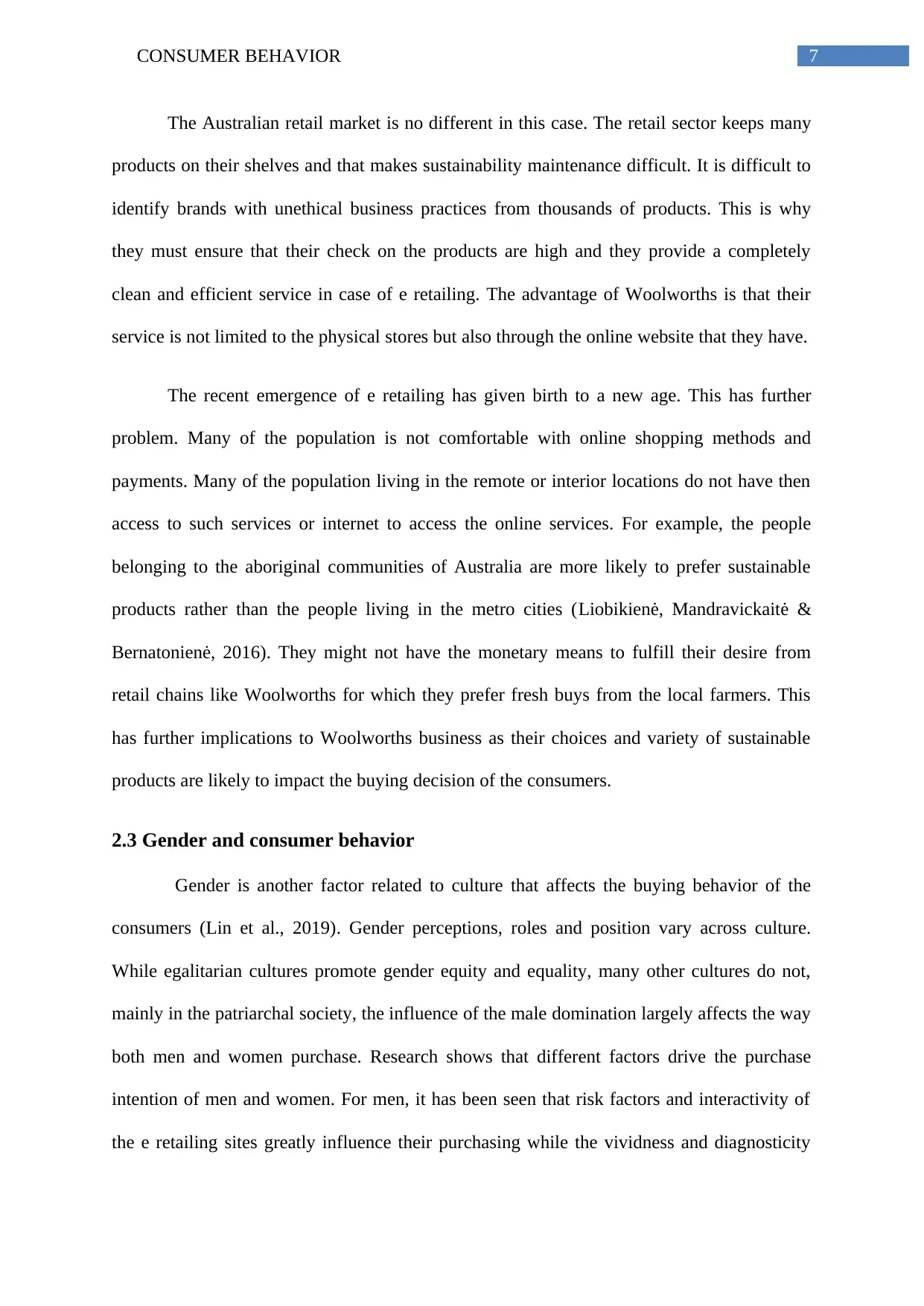
7CONSUMER BEHAVIOR
The Australian retail market is no different in this case. The retail sector keeps many
products on their shelves and that makes sustainability maintenance difficult. It is difficult to
identify brands with unethical business practices from thousands of products. This is why
they must ensure that their check on the products are high and they provide a completely
clean and efficient service in case of e retailing. The advantage of Woolworths is that their
service is not limited to the physical stores but also through the online website that they have.
The recent emergence of e retailing has given birth to a new age. This has further
problem. Many of the population is not comfortable with online shopping methods and
payments. Many of the population living in the remote or interior locations do not have then
access to such services or internet to access the online services. For example, the people
belonging to the aboriginal communities of Australia are more likely to prefer sustainable
products rather than the people living in the metro cities (Liobikienė, Mandravickaitė &
Bernatonienė, 2016). They might not have the monetary means to fulfill their desire from
retail chains like Woolworths for which they prefer fresh buys from the local farmers. This
has further implications to Woolworths business as their choices and variety of sustainable
products are likely to impact the buying decision of the consumers.
2.3 Gender and consumer behavior
Gender is another factor related to culture that affects the buying behavior of the
consumers (Lin et al., 2019). Gender perceptions, roles and position vary across culture.
While egalitarian cultures promote gender equity and equality, many other cultures do not,
mainly in the patriarchal society, the influence of the male domination largely affects the way
both men and women purchase. Research shows that different factors drive the purchase
intention of men and women. For men, it has been seen that risk factors and interactivity of
the e retailing sites greatly influence their purchasing while the vividness and diagnosticity
The Australian retail market is no different in this case. The retail sector keeps many
products on their shelves and that makes sustainability maintenance difficult. It is difficult to
identify brands with unethical business practices from thousands of products. This is why
they must ensure that their check on the products are high and they provide a completely
clean and efficient service in case of e retailing. The advantage of Woolworths is that their
service is not limited to the physical stores but also through the online website that they have.
The recent emergence of e retailing has given birth to a new age. This has further
problem. Many of the population is not comfortable with online shopping methods and
payments. Many of the population living in the remote or interior locations do not have then
access to such services or internet to access the online services. For example, the people
belonging to the aboriginal communities of Australia are more likely to prefer sustainable
products rather than the people living in the metro cities (Liobikienė, Mandravickaitė &
Bernatonienė, 2016). They might not have the monetary means to fulfill their desire from
retail chains like Woolworths for which they prefer fresh buys from the local farmers. This
has further implications to Woolworths business as their choices and variety of sustainable
products are likely to impact the buying decision of the consumers.
2.3 Gender and consumer behavior
Gender is another factor related to culture that affects the buying behavior of the
consumers (Lin et al., 2019). Gender perceptions, roles and position vary across culture.
While egalitarian cultures promote gender equity and equality, many other cultures do not,
mainly in the patriarchal society, the influence of the male domination largely affects the way
both men and women purchase. Research shows that different factors drive the purchase
intention of men and women. For men, it has been seen that risk factors and interactivity of
the e retailing sites greatly influence their purchasing while the vividness and diagnosticity
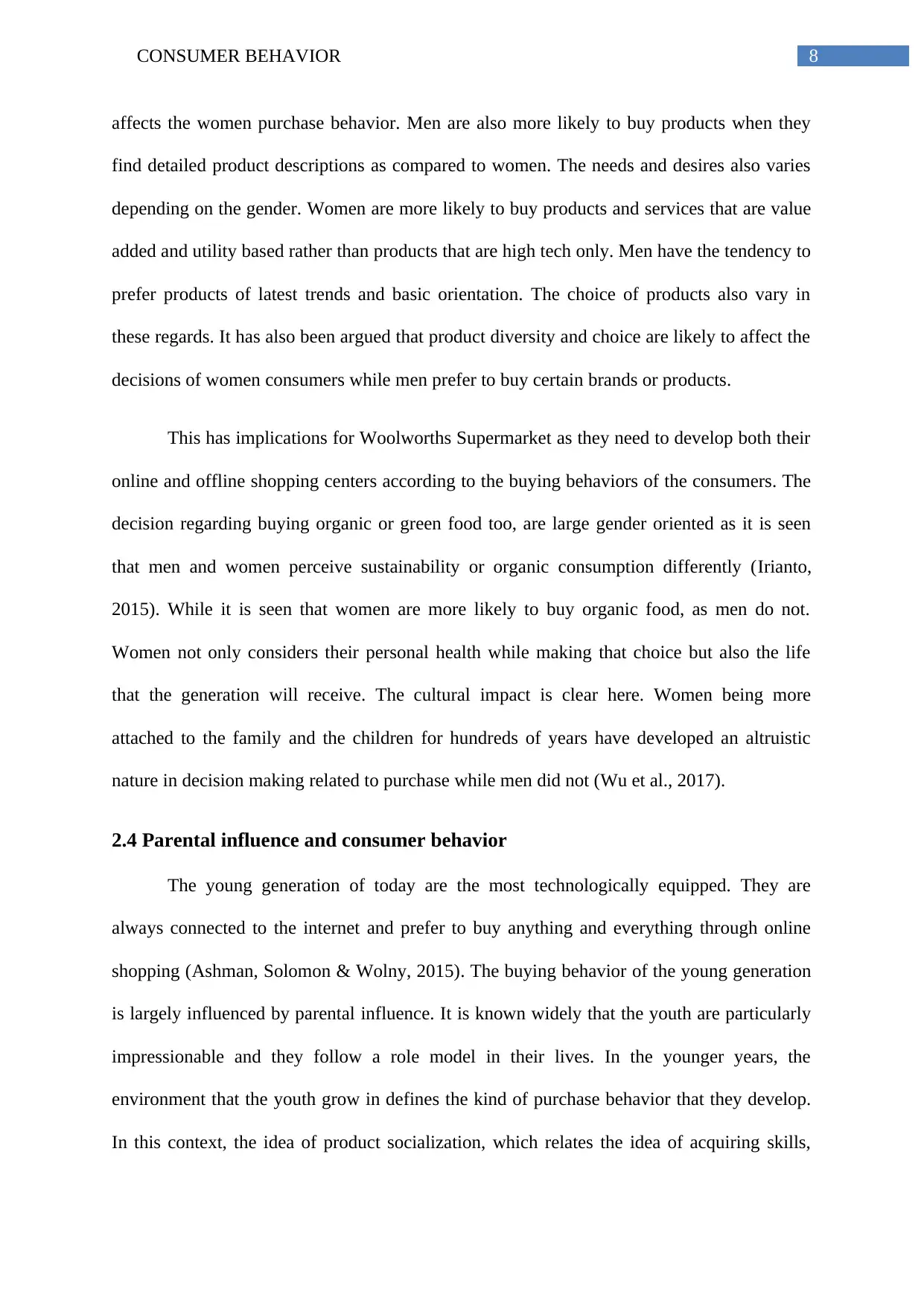
8CONSUMER BEHAVIOR
affects the women purchase behavior. Men are also more likely to buy products when they
find detailed product descriptions as compared to women. The needs and desires also varies
depending on the gender. Women are more likely to buy products and services that are value
added and utility based rather than products that are high tech only. Men have the tendency to
prefer products of latest trends and basic orientation. The choice of products also vary in
these regards. It has also been argued that product diversity and choice are likely to affect the
decisions of women consumers while men prefer to buy certain brands or products.
This has implications for Woolworths Supermarket as they need to develop both their
online and offline shopping centers according to the buying behaviors of the consumers. The
decision regarding buying organic or green food too, are large gender oriented as it is seen
that men and women perceive sustainability or organic consumption differently (Irianto,
2015). While it is seen that women are more likely to buy organic food, as men do not.
Women not only considers their personal health while making that choice but also the life
that the generation will receive. The cultural impact is clear here. Women being more
attached to the family and the children for hundreds of years have developed an altruistic
nature in decision making related to purchase while men did not (Wu et al., 2017).
2.4 Parental influence and consumer behavior
The young generation of today are the most technologically equipped. They are
always connected to the internet and prefer to buy anything and everything through online
shopping (Ashman, Solomon & Wolny, 2015). The buying behavior of the young generation
is largely influenced by parental influence. It is known widely that the youth are particularly
impressionable and they follow a role model in their lives. In the younger years, the
environment that the youth grow in defines the kind of purchase behavior that they develop.
In this context, the idea of product socialization, which relates the idea of acquiring skills,
affects the women purchase behavior. Men are also more likely to buy products when they
find detailed product descriptions as compared to women. The needs and desires also varies
depending on the gender. Women are more likely to buy products and services that are value
added and utility based rather than products that are high tech only. Men have the tendency to
prefer products of latest trends and basic orientation. The choice of products also vary in
these regards. It has also been argued that product diversity and choice are likely to affect the
decisions of women consumers while men prefer to buy certain brands or products.
This has implications for Woolworths Supermarket as they need to develop both their
online and offline shopping centers according to the buying behaviors of the consumers. The
decision regarding buying organic or green food too, are large gender oriented as it is seen
that men and women perceive sustainability or organic consumption differently (Irianto,
2015). While it is seen that women are more likely to buy organic food, as men do not.
Women not only considers their personal health while making that choice but also the life
that the generation will receive. The cultural impact is clear here. Women being more
attached to the family and the children for hundreds of years have developed an altruistic
nature in decision making related to purchase while men did not (Wu et al., 2017).
2.4 Parental influence and consumer behavior
The young generation of today are the most technologically equipped. They are
always connected to the internet and prefer to buy anything and everything through online
shopping (Ashman, Solomon & Wolny, 2015). The buying behavior of the young generation
is largely influenced by parental influence. It is known widely that the youth are particularly
impressionable and they follow a role model in their lives. In the younger years, the
environment that the youth grow in defines the kind of purchase behavior that they develop.
In this context, the idea of product socialization, which relates the idea of acquiring skills,
⊘ This is a preview!⊘
Do you want full access?
Subscribe today to unlock all pages.

Trusted by 1+ million students worldwide
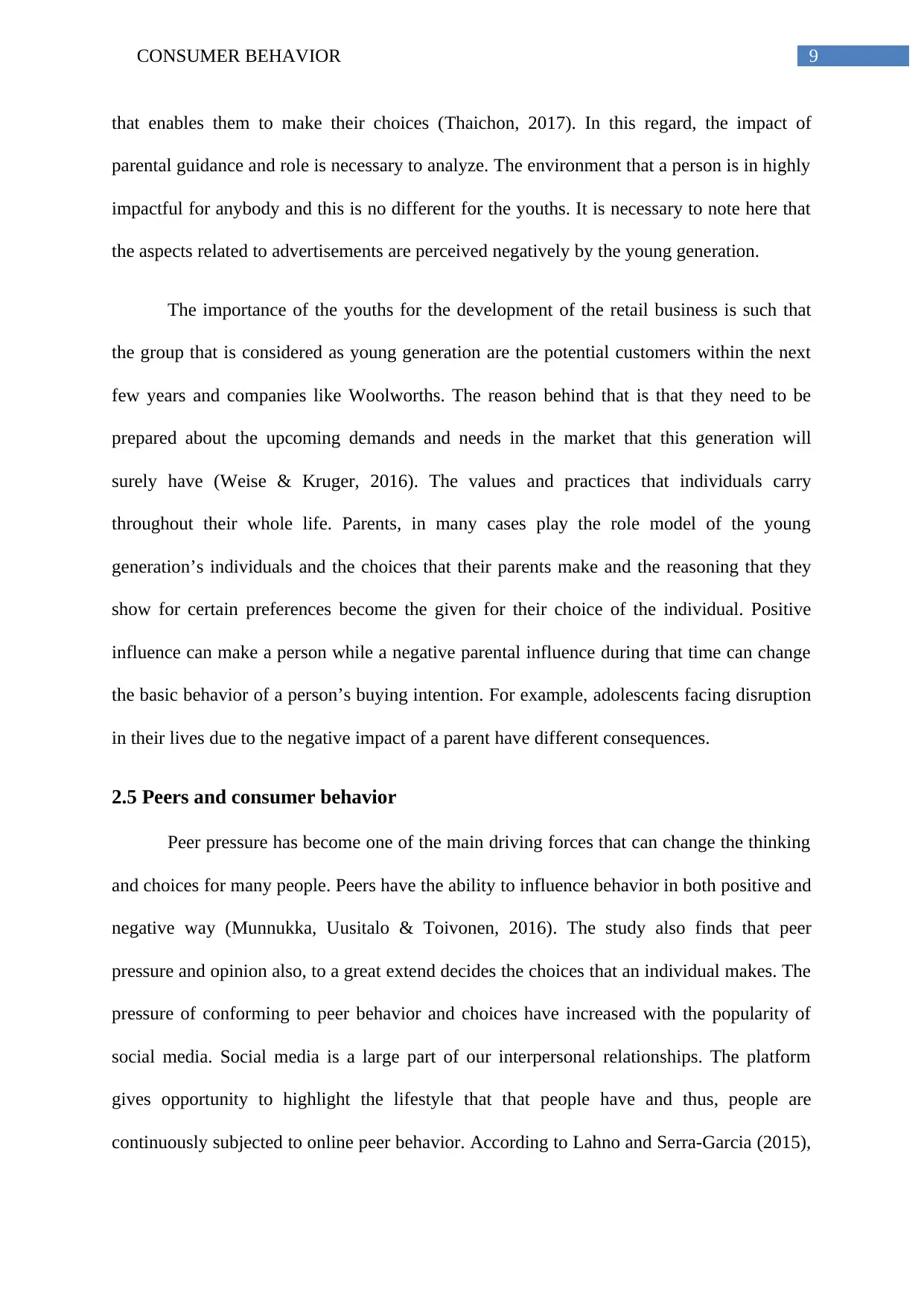
9CONSUMER BEHAVIOR
that enables them to make their choices (Thaichon, 2017). In this regard, the impact of
parental guidance and role is necessary to analyze. The environment that a person is in highly
impactful for anybody and this is no different for the youths. It is necessary to note here that
the aspects related to advertisements are perceived negatively by the young generation.
The importance of the youths for the development of the retail business is such that
the group that is considered as young generation are the potential customers within the next
few years and companies like Woolworths. The reason behind that is that they need to be
prepared about the upcoming demands and needs in the market that this generation will
surely have (Weise & Kruger, 2016). The values and practices that individuals carry
throughout their whole life. Parents, in many cases play the role model of the young
generation’s individuals and the choices that their parents make and the reasoning that they
show for certain preferences become the given for their choice of the individual. Positive
influence can make a person while a negative parental influence during that time can change
the basic behavior of a person’s buying intention. For example, adolescents facing disruption
in their lives due to the negative impact of a parent have different consequences.
2.5 Peers and consumer behavior
Peer pressure has become one of the main driving forces that can change the thinking
and choices for many people. Peers have the ability to influence behavior in both positive and
negative way (Munnukka, Uusitalo & Toivonen, 2016). The study also finds that peer
pressure and opinion also, to a great extend decides the choices that an individual makes. The
pressure of conforming to peer behavior and choices have increased with the popularity of
social media. Social media is a large part of our interpersonal relationships. The platform
gives opportunity to highlight the lifestyle that that people have and thus, people are
continuously subjected to online peer behavior. According to Lahno and Serra-Garcia (2015),
that enables them to make their choices (Thaichon, 2017). In this regard, the impact of
parental guidance and role is necessary to analyze. The environment that a person is in highly
impactful for anybody and this is no different for the youths. It is necessary to note here that
the aspects related to advertisements are perceived negatively by the young generation.
The importance of the youths for the development of the retail business is such that
the group that is considered as young generation are the potential customers within the next
few years and companies like Woolworths. The reason behind that is that they need to be
prepared about the upcoming demands and needs in the market that this generation will
surely have (Weise & Kruger, 2016). The values and practices that individuals carry
throughout their whole life. Parents, in many cases play the role model of the young
generation’s individuals and the choices that their parents make and the reasoning that they
show for certain preferences become the given for their choice of the individual. Positive
influence can make a person while a negative parental influence during that time can change
the basic behavior of a person’s buying intention. For example, adolescents facing disruption
in their lives due to the negative impact of a parent have different consequences.
2.5 Peers and consumer behavior
Peer pressure has become one of the main driving forces that can change the thinking
and choices for many people. Peers have the ability to influence behavior in both positive and
negative way (Munnukka, Uusitalo & Toivonen, 2016). The study also finds that peer
pressure and opinion also, to a great extend decides the choices that an individual makes. The
pressure of conforming to peer behavior and choices have increased with the popularity of
social media. Social media is a large part of our interpersonal relationships. The platform
gives opportunity to highlight the lifestyle that that people have and thus, people are
continuously subjected to online peer behavior. According to Lahno and Serra-Garcia (2015),
Paraphrase This Document
Need a fresh take? Get an instant paraphrase of this document with our AI Paraphraser
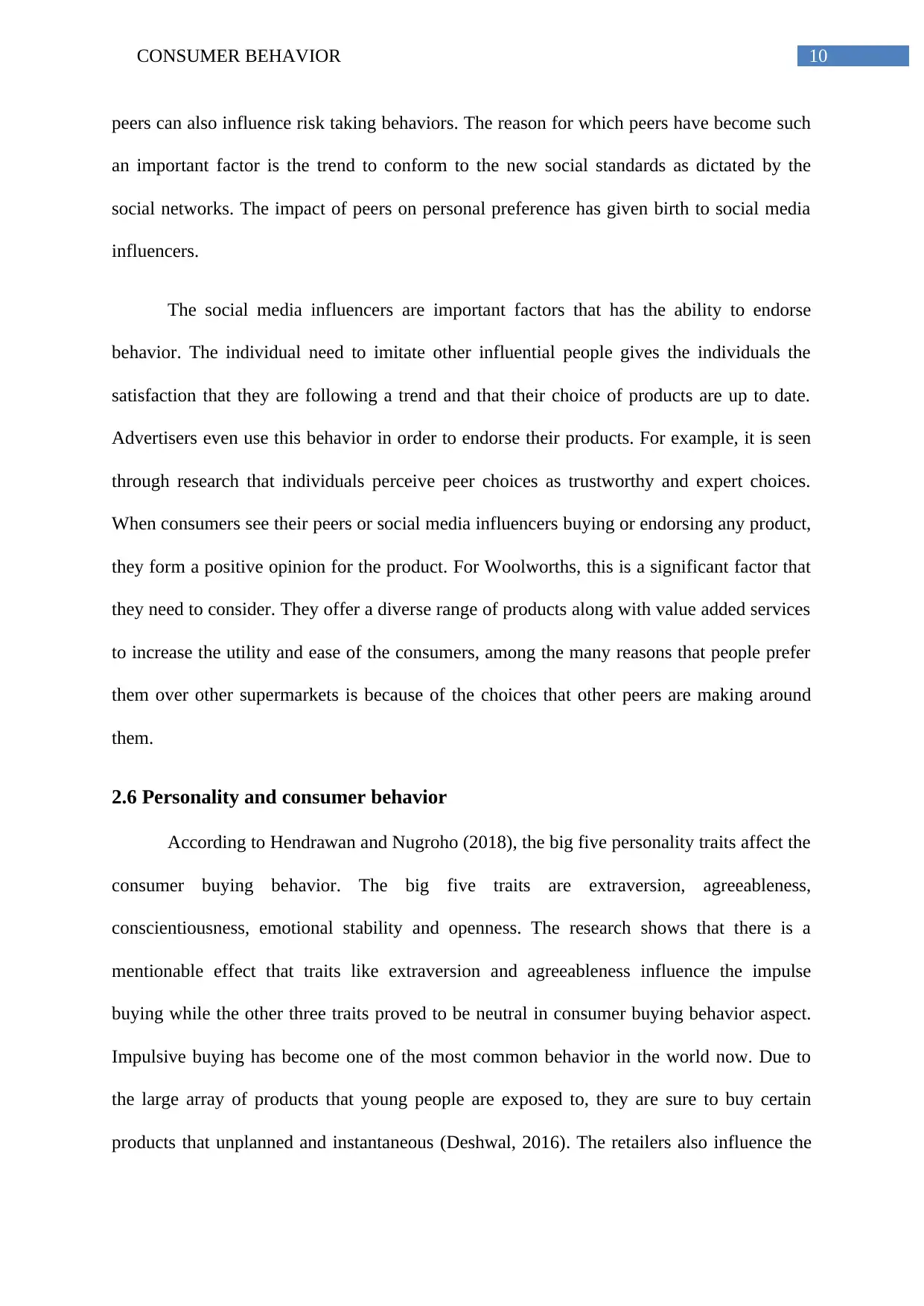
10CONSUMER BEHAVIOR
peers can also influence risk taking behaviors. The reason for which peers have become such
an important factor is the trend to conform to the new social standards as dictated by the
social networks. The impact of peers on personal preference has given birth to social media
influencers.
The social media influencers are important factors that has the ability to endorse
behavior. The individual need to imitate other influential people gives the individuals the
satisfaction that they are following a trend and that their choice of products are up to date.
Advertisers even use this behavior in order to endorse their products. For example, it is seen
through research that individuals perceive peer choices as trustworthy and expert choices.
When consumers see their peers or social media influencers buying or endorsing any product,
they form a positive opinion for the product. For Woolworths, this is a significant factor that
they need to consider. They offer a diverse range of products along with value added services
to increase the utility and ease of the consumers, among the many reasons that people prefer
them over other supermarkets is because of the choices that other peers are making around
them.
2.6 Personality and consumer behavior
According to Hendrawan and Nugroho (2018), the big five personality traits affect the
consumer buying behavior. The big five traits are extraversion, agreeableness,
conscientiousness, emotional stability and openness. The research shows that there is a
mentionable effect that traits like extraversion and agreeableness influence the impulse
buying while the other three traits proved to be neutral in consumer buying behavior aspect.
Impulsive buying has become one of the most common behavior in the world now. Due to
the large array of products that young people are exposed to, they are sure to buy certain
products that unplanned and instantaneous (Deshwal, 2016). The retailers also influence the
peers can also influence risk taking behaviors. The reason for which peers have become such
an important factor is the trend to conform to the new social standards as dictated by the
social networks. The impact of peers on personal preference has given birth to social media
influencers.
The social media influencers are important factors that has the ability to endorse
behavior. The individual need to imitate other influential people gives the individuals the
satisfaction that they are following a trend and that their choice of products are up to date.
Advertisers even use this behavior in order to endorse their products. For example, it is seen
through research that individuals perceive peer choices as trustworthy and expert choices.
When consumers see their peers or social media influencers buying or endorsing any product,
they form a positive opinion for the product. For Woolworths, this is a significant factor that
they need to consider. They offer a diverse range of products along with value added services
to increase the utility and ease of the consumers, among the many reasons that people prefer
them over other supermarkets is because of the choices that other peers are making around
them.
2.6 Personality and consumer behavior
According to Hendrawan and Nugroho (2018), the big five personality traits affect the
consumer buying behavior. The big five traits are extraversion, agreeableness,
conscientiousness, emotional stability and openness. The research shows that there is a
mentionable effect that traits like extraversion and agreeableness influence the impulse
buying while the other three traits proved to be neutral in consumer buying behavior aspect.
Impulsive buying has become one of the most common behavior in the world now. Due to
the large array of products that young people are exposed to, they are sure to buy certain
products that unplanned and instantaneous (Deshwal, 2016). The retailers also influence the
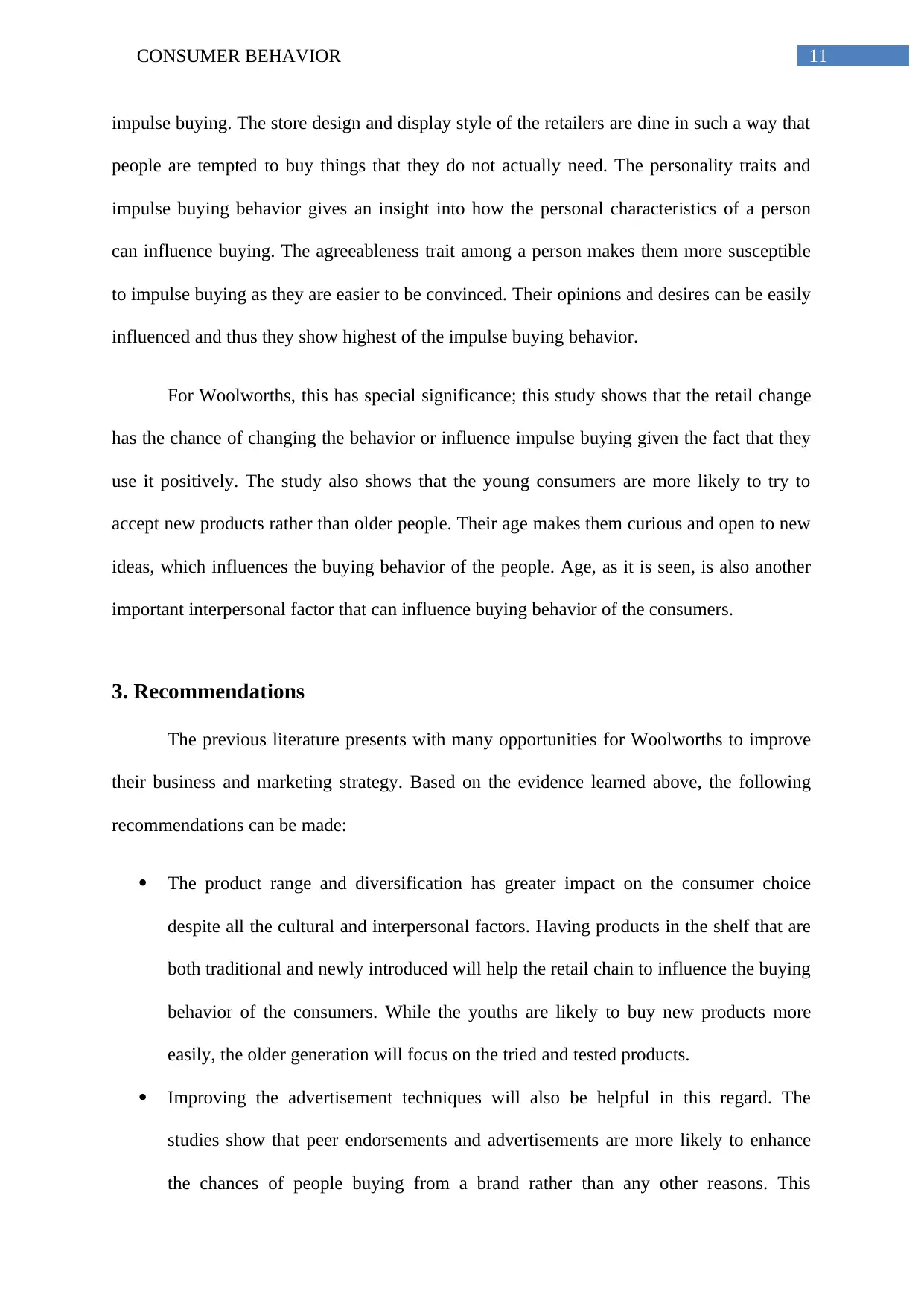
11CONSUMER BEHAVIOR
impulse buying. The store design and display style of the retailers are dine in such a way that
people are tempted to buy things that they do not actually need. The personality traits and
impulse buying behavior gives an insight into how the personal characteristics of a person
can influence buying. The agreeableness trait among a person makes them more susceptible
to impulse buying as they are easier to be convinced. Their opinions and desires can be easily
influenced and thus they show highest of the impulse buying behavior.
For Woolworths, this has special significance; this study shows that the retail change
has the chance of changing the behavior or influence impulse buying given the fact that they
use it positively. The study also shows that the young consumers are more likely to try to
accept new products rather than older people. Their age makes them curious and open to new
ideas, which influences the buying behavior of the people. Age, as it is seen, is also another
important interpersonal factor that can influence buying behavior of the consumers.
3. Recommendations
The previous literature presents with many opportunities for Woolworths to improve
their business and marketing strategy. Based on the evidence learned above, the following
recommendations can be made:
The product range and diversification has greater impact on the consumer choice
despite all the cultural and interpersonal factors. Having products in the shelf that are
both traditional and newly introduced will help the retail chain to influence the buying
behavior of the consumers. While the youths are likely to buy new products more
easily, the older generation will focus on the tried and tested products.
Improving the advertisement techniques will also be helpful in this regard. The
studies show that peer endorsements and advertisements are more likely to enhance
the chances of people buying from a brand rather than any other reasons. This
impulse buying. The store design and display style of the retailers are dine in such a way that
people are tempted to buy things that they do not actually need. The personality traits and
impulse buying behavior gives an insight into how the personal characteristics of a person
can influence buying. The agreeableness trait among a person makes them more susceptible
to impulse buying as they are easier to be convinced. Their opinions and desires can be easily
influenced and thus they show highest of the impulse buying behavior.
For Woolworths, this has special significance; this study shows that the retail change
has the chance of changing the behavior or influence impulse buying given the fact that they
use it positively. The study also shows that the young consumers are more likely to try to
accept new products rather than older people. Their age makes them curious and open to new
ideas, which influences the buying behavior of the people. Age, as it is seen, is also another
important interpersonal factor that can influence buying behavior of the consumers.
3. Recommendations
The previous literature presents with many opportunities for Woolworths to improve
their business and marketing strategy. Based on the evidence learned above, the following
recommendations can be made:
The product range and diversification has greater impact on the consumer choice
despite all the cultural and interpersonal factors. Having products in the shelf that are
both traditional and newly introduced will help the retail chain to influence the buying
behavior of the consumers. While the youths are likely to buy new products more
easily, the older generation will focus on the tried and tested products.
Improving the advertisement techniques will also be helpful in this regard. The
studies show that peer endorsements and advertisements are more likely to enhance
the chances of people buying from a brand rather than any other reasons. This
⊘ This is a preview!⊘
Do you want full access?
Subscribe today to unlock all pages.

Trusted by 1+ million students worldwide
1 out of 17
Related Documents
Your All-in-One AI-Powered Toolkit for Academic Success.
+13062052269
info@desklib.com
Available 24*7 on WhatsApp / Email
![[object Object]](/_next/static/media/star-bottom.7253800d.svg)
Unlock your academic potential
Copyright © 2020–2025 A2Z Services. All Rights Reserved. Developed and managed by ZUCOL.





